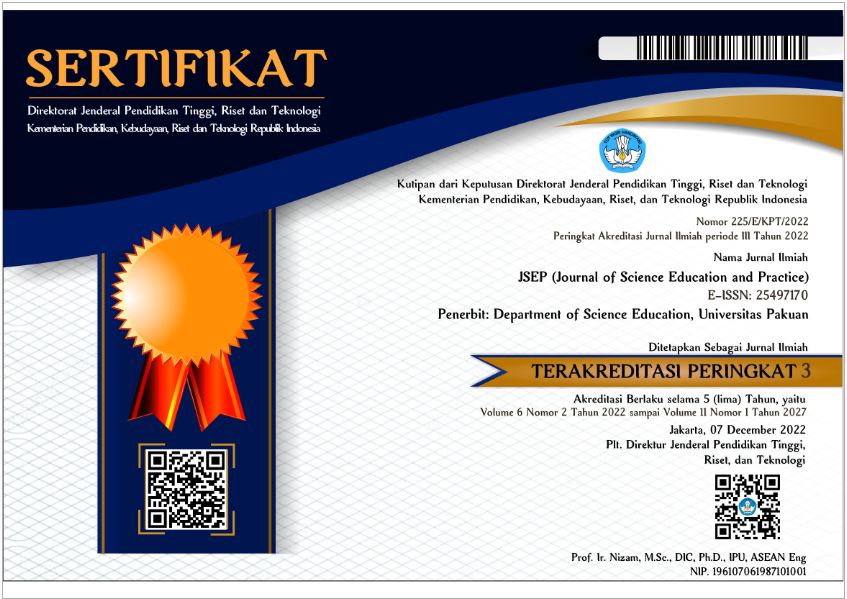ADDITIONAL MENU
Multimedia Development Of Science Learning Based On Science Literacy on The Theme of Lightning
Abstract
This study aims to obtain: (1) multimedia design in science learning on the theme of lightning based on science literacy, (2) student science literacy information after multimedia-assisted science learning on the lightning theme, (3) student response information to multimedia in science learning based on science literacy on the lightning theme. The method used in this study was Research and Development with the ADDIE model, while the research design used pre-experimental pre-test post test only. The population in this study was grade IX students of one of the junior high schools in Cianjur district for the 2016-2017 academic year with a sample of 31 people determined using the purposive sample method. To test the feasibility of multimedia, judgments were carried out by expert lecturers, while students' science literacy data was collected by providing science literacy questions and student responses regarding multimedia were collected through questionnaires given to students. Based on the results of judgments of material experts and lecturers, it shows that aspects of multimedia design quality, aspects of multimedia attractiveness, aspects of multimedia interactiveness and aspects of material conformity with the curriculum are included in the category of excellent. From the results of data processing, it was obtained that students' science literacy abilities had a significant increase in pre-test and post-test scores. Meanwhile, students' responses to multimedia are very good in the aspect of science literacy content and aspects of potential to increase motivation, while in the aspect of ease of operating multimedia the category is good.
Keywords
References
Aisyah,S. (2013). Application of Leraning Cycle 5E Learning Model Assisted by Multimedia Flash Equipped with LKS to Increase Student Activity and Achievement on the Subject matter of Addictive Substances and Psychotropics Class VIII SMPN 4 Surakarta Academic Year 2011-2012. Journal of Chemistry Education, 2 (2).
Arikunto, S. (2010). Research Procedures A Practical Approach. Jakarta : Rineka Cipta.
Arisman, A. & Permanasari,A . (2015). Application of STAD-type Cooperative Learning with Practicum Method and Interactive Multimedia Demonstration
. MMI. in Integrated Science Learning To Improve Students' Science Literacy. Edusains, 7 (2), 179-184.
Arsyad,M . (2016). Presentation of Aspects of Science Literacy in Science Learning at Bandumg City Junior High School. (Thesis). Graduate School of Indonesian University of Education, Bandung.
Bahriah, E.S. (2012). Development of Interactive Multimedia Equilibrium Chemistry To Improve Students' Science Literacy. (Thesis), Indonesian University of Education, Bandung.
Falvo,D. (2008). Animations and Simulations for teaching and learning moleculer chemistry. International Journal of Technology in Teaching and Learning, 4 (1), 68-77
Giorgiou,J. (2007). A Virtual Reality Laboratory For Distance Education In Chemistry. International Journal Of Social and Human Sciences.1
Josephsen, J.& Kistensen, A.K. (2006). Simulation Of Laboratory Assignments To Support Students Learning Of Introductory Inorganio Chemistry. Chemistry Education Research And Practice. 7.No 4:266-279
Kozma, R & Russel, J. (1997). Multimedia and Understanding: Expert and Novice Responses to Different Representations of Chemical Phenomena. Journal Of Research In Science Theaching, 34 (9), 949-968.
Latif, A . (2015). Pengembangan Multimedia Pembelajaran Berbasis Literasi Sains Untuk Siswa SMP Pada Tema Teknologi. (Tesis). Sekolah Pascasarjana Universitas Pendidikan Indonesia, Bandung.
Melvi. (2006). Pengaruh Penggunaan Multimedia Hypertext†Terhadap Hasil Belajar Biologi Siswa Kelas XI MAN 2 Pada Tahun Pelajaran 2005-2006. (Skripsi). Universitas Negeri Padang, Padang.
Oktarisa. (2017). Penerapan Model Pembelajaran Berbasis Pengalaman. Jurnal Untirta ac.id, 3 (2).
Osman,K. (2007). Sikap Terhadap Sains dan Sikap Saintifik dikalngan Pelajar Sains. Jurnal Pendidikan, 32, 39-60.
Retmana, L.R. (2010). Pembelajaran Berbasis Multimedia Interaktif Untuk Menigkatkan Kemampuan Literasi Sains Siswa SMP. (Tesis), Sekolah Pascasarjana Universitas Pendidikan Indonesia, Bandung
Sahin. (2016). Teaching Floating and Sinking Concepts With Diferent Methods and Based On The 5E Instructional Model. Asia- Pacific Forum On Science Learning and Teaching. 11 (12), 1-39.
Tatli,Z. & Ayas ,A . (2012). Virtual Chemistry Laboratory : Effect Of Constructivist Learning Environment. Turkish On line Journal Of Distance Education. 13 (1), 183-199.
Toharudin,U. (2010). Kajian Pengembangan Bahan Ajar Berorientasi Literasi Sains Untuk Pendidikan Dasar. Disertasi. Sekolah Pascasarjana, Universitas Pendidikan Indonesia, Bandung.
Yen Chung, (2002). Comparing The Impact of Problem-Based Assisten Instruction and the direct interactive Teading Methode On Student Since Achievment. Journal of Science Education and Technology. 10 (2), 147- 153.
DOI: 10.33751/jsep.v3i2.1722
 Abstract views : 333
Abstract views : 333
Refbacks
- There are currently no refbacks.
Copyright (c) 2022 JSEP (Journal of Science Education and Practice)

This work is licensed under a Creative Commons Attribution 4.0 International License.












